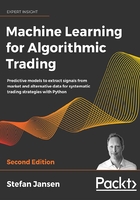
7 Linear Models – From Risk Factors to Return Forecasts
The family of linear models represents one of the most useful hypothesis classes. Many learning algorithms that are widely applied in algorithmic trading rely on linear predictors because they can be efficiently trained, are relatively robust to noisy financial data, and have strong links to the theory of finance. Linear predictors are also intuitive, easy to interpret, and often fit the data reasonably well or at least provide a good baseline.
Linear regression has been known for over 200 years, since Legendre and Gauss applied it to astronomy and began to analyze its statistical properties. Numerous extensions have since adapted the linear regression model and the baseline ordinary least squares (OLS) method to learn its parameters:
- Generalized linear models (GLM) expand the scope of applications by allowing for response variables that imply an error distribution other than the normal distribution. GLMs include the probit or logistic models for categorical response variables that appear in classification problems.
- More robust estimation methods enable statistical inference where the data violates baseline assumptions due to, for example, correlation over time or across observations. This is often the case with panel data that contains repeated observations on the same units, such as historical returns on a universe of assets.
- Shrinkage methods aim to improve the predictive performance of linear models. They use a complexity penalty that biases the coefficients learned by the model, with the goal of reducing the model's variance and improving out-of-sample predictive performance.
In practice, linear models are applied to regression and classification problems with the goals of inference and prediction. Numerous asset pricing models have been developed by academic and industry researchers that leverage linear regression. Applications include the identification of significant factors that drive asset returns for better risk and performance management, as well as the prediction of returns over various time horizons. Classification problems, on the other hand, include directional price forecasts.
In this chapter, we will cover the following topics:
- How linear regression works and which assumptions it makes
- Training and diagnosing linear regression models
- Using linear regression to predict stock returns
- Use regularization to improve predictive performance
- How logistic regression works
- Converting a regression into a classification problem
You can find the code samples for this chapter and links to additional resources in the corresponding directory of the GitHub repository. The notebooks include color versions of the images.